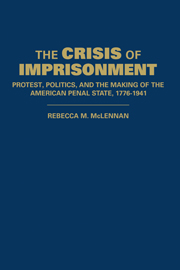Book contents
- Frontmatter
- Contents
- Acknowledgments
- Introduction: The Grounds of Legal Punishment
- 1 Strains of Servitude: Legal Punishment in the Early Republic
- 2 Due Convictions: Contractual Penal Servitude and Its Discontents, 1818–1865
- 3 Commerce upon the Throne: The Business of Imprisonment in Gilded Age America
- 4 Disciplining the State, Civilizing the Market: The Campaign to Abolish Contract Prison Labor
- 5 A Model Servitude: Prison Reform in the Early Progressive Era
- 6 Uses of the State: The Dialectics of Penal Reform in Early Progressive New York
- 7 American Bastille: Sing Sing and the Political Crisis of Imprisonment
- 8 Changing the Subject: The Metamorphosis of Prison Reform in the High Progressive Era
- 9 Laboratory of Social Justice: The New Penologists at Sing Sing, 1915–1917
- 10 Punishment without Labor: Toward the Modern Penal State
- Conclusion: On the Crises of Imprisonment
- Select Bibliography
- Index
4 - Disciplining the State, Civilizing the Market: The Campaign to Abolish Contract Prison Labor
Published online by Cambridge University Press: 18 August 2009
- Frontmatter
- Contents
- Acknowledgments
- Introduction: The Grounds of Legal Punishment
- 1 Strains of Servitude: Legal Punishment in the Early Republic
- 2 Due Convictions: Contractual Penal Servitude and Its Discontents, 1818–1865
- 3 Commerce upon the Throne: The Business of Imprisonment in Gilded Age America
- 4 Disciplining the State, Civilizing the Market: The Campaign to Abolish Contract Prison Labor
- 5 A Model Servitude: Prison Reform in the Early Progressive Era
- 6 Uses of the State: The Dialectics of Penal Reform in Early Progressive New York
- 7 American Bastille: Sing Sing and the Political Crisis of Imprisonment
- 8 Changing the Subject: The Metamorphosis of Prison Reform in the High Progressive Era
- 9 Laboratory of Social Justice: The New Penologists at Sing Sing, 1915–1917
- 10 Punishment without Labor: Toward the Modern Penal State
- Conclusion: On the Crises of Imprisonment
- Select Bibliography
- Index
Summary
Sour bread, sour bread; no work, no work.
Convicts' mess hall chant, Sing Sing Prison, 1870sIn the Gilded Age, contractors and their agents exercised power far more effectively than did the great mass of unfree, dependent prisoners in their charge; but they did not exercise it just as they pleased. Rewriting the prison rulebooks, ordering speed-ups in production, and prescribing new ways of organizing and disciplining convict workers were easy enough; but actually implementing the rules and successfully subjecting the convicts (and the state's keepers) to the disciplinary rigors of the new regime posed a far more difficult set of challenges. In the early stages of restructuring (c. 1872–78), prisoners in every region of the country rebelled and struck against the reforms with an intensity and confidence unseen since the days of the early republican penitentiary and its feisty, rights-conscious inmates. Once the authorities put down these rebellions and submitted their prisoners to the discipline of large-scale industrial labor, they soon discovered that the very structure of the new, large-scale contract industries afforded new opportunities – and new means – of individual and collective acts of defiance. Indeed, the very success of the consolidated contract system was to have some deeply contradictory effects, including the destabilization of the system itself.
Nor were these the only difficulties with which large-scale contractors and the state authorities had to contend in the Gilded Age.
- Type
- Chapter
- Information
- The Crisis of ImprisonmentProtest, Politics, and the Making of the American Penal State, 1776–1941, pp. 137 - 192Publisher: Cambridge University PressPrint publication year: 2008
- 1
- Cited by



